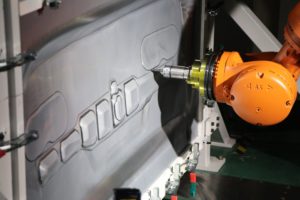Nissan has developed a new way of using robots to make car parts out of sheet steel, a breakthrough that could make replacement parts for discontinued models more widely available for customers.
The Japanese automotive OEM hopes to commercialise the proprietary technique, known as dual-sided dieless forming, which involves two synchronised robots working from opposite sides of a steel sheet, using diamond-coated tools to gradually shape the steel.
Not only does this reduce friction and eliminate the need for lubrication, but it also has numerous other benefits, including consistency of surface quality and low-cost, environmentally friendly operation.
Furthermore, generation of optimised pathfinding logic for robots, drawing on press-forming simulation techniques ordinarily used by Nissan’s production engineering teams, has enabled the car maker to achieve high quality results early in the development process.

According to Nissan, due to its flexible production, short lead times and minimal upfront costs, the new technique could make it commercially viable to produce and sell a wide variety of after-service and replacement parts in small volumes for cars that Nissan no longer makes.
This was previously not possible due to the high upfront costs and long lead times to develop and make dies for stamped parts.
Until now, dual-sided dieless forming had been considered by Nissan to be too difficult to commercialise. This was due to the complexity of programming two robots to operate synchronously while ensuring consistent quality.
Existing techniques have primarily relied on single-sided forming, which limits the complexity of shapes that can be created.
However, by placing robots and tools on opposite sides of a steel sheet, they can create more difficult and detailed convex and concave shapes.
The new technique was developed at Nissan’s Production Engineering Research and Development Center alongside advancements in materials technology made by Nissan’s research division.
Nissan says it plans to continue pursuing advancements in mass production while also dedicating R&D resources to honing flexible low-volume production techniques.







